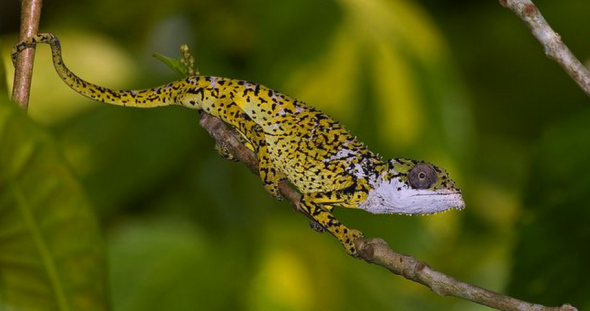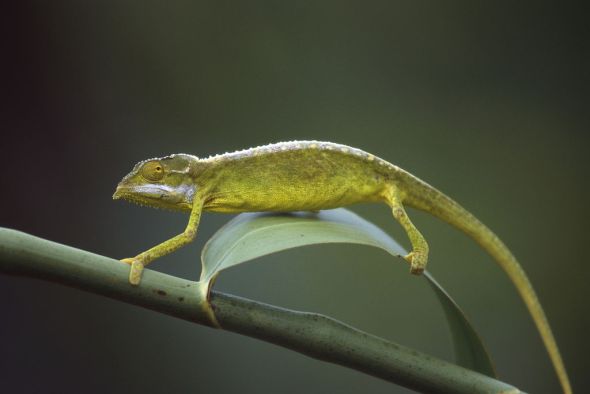Endangered Species Monday: Archaius tigris
Endangered Species Monday: Archaius tigris
This Mondays Endangered Species watch Post (ESP) I document on yet another African species of wildlife that hunting revenue is not helping to preserve. The Tiger Chameleon was identified back in 1820 by Dr Heinrich Kuhl (September 17, 1797 – September 14, 1821) was a German naturalist and zoologist. Kuhl was born in Hanau. He became assistant to Coenraad Jacob Temminck at the Leiden Rijksmuseum van Natuurlijke Historie. (Image: Credited to Henrick Bringsoe, A tigris).
In 1817 he published a monograph on bats, and in 1819 he published a survey of the parrots, Conspectus psittacorum. He also published the first monograph on the petrels, and a list of all the birds illustrated in Daubenton’s Planches Enluminées and with his friend Johan Coenraad van Hasselt (1797–1823) Beiträge zur Zoologie und vergleichenden Anatomie (“Contributions to Zoology and Comparative Anatomy”) that were published at Frankfurt-am-Main, 1820.
Commonly known as the Tiger Chameleon or Seychelles Tiger Chameleon the species is currently listed as [endangered] which is not uncommon as like many Chameleons within the Seychelles their range is shrinking by the year or being overrun by invasive botanical species.
Endemic to the Seychelles the species has been listed as endangered since 2006 of which populations trends are unknown. Much documentation often cites the species at “comparatively” low density, however one must not take this as factual until a true population count is seen. It has been alleged that for every [five hectares] there is possibly 2.07 individuals which isn’t good ‘if true’ since the island is only 455 km2.
From what we know the species remains undisturbed where there aren’t invasive Cinnamon trees identified as the Cinnamomum verum. However where C. verum is spreading the Tiger Chameleons habitat is under threat from this invasive plant. There is a negative correlation between Chameleon density and the presence of cinnamon, suggesting this invasion is detrimental to chameleon populations. Negative correlation is a relationship between two variables such that as the value of one variable increases, the other decreases.
The Tiger Chameleon’s main endemic range on the Seychelles islands is Mahé, Silhouette and Praslin. A historical record from Zanzibar (Tanzania) is erroneous. It occurs from sea level to 550 m asl, in areas of the islands that have either primary or secondary forest, or in the transformed landscape if there are trees and bushes present. Although they are currently estimated to have a restricted distribution on each island (following survey transects conducted by Dr Gerlach if anecdotal observations from transformed landscapes (e.g. degraded areas outside the areas surveyed) are valid, then the distribution would be larger than mapped at present.
To date the only [non-active] conservation actions that I am aware of are within the Vallee de Mai on Praslin which is currently not a protected national park. Fortunately the species is protected to some degree in the Morne Seychelles, Praslin and Silhouette National Parks. The primary threat within non-protected areas is as explained invasive Cinnamon which seems to be posing similar threats to both small reptilians, insects and birds on the islands and mainland Madagascar.
While the species has been in the past used as a trade animal it was alleged that there were no Cites quotes since 2000 - 2014. However from 1997 - 2013 a total of twelve live specimens were legally exported [despite the species threatened at risk status]. Cites allowed the twelve species to be exported for use within the pet trade which I myself find somewhat confusing. Two specimens were exported to Germany in 1981 with the remainder [10] sent to Spain. I am a little perplexed as to why these twelve specimens were legally exported, furthermore I have found no evidence or follow up data that would satisfy me in believing this export was even worthwhile for the species currently losing ground within their natural habitat.
From 1981 -2010 a further 98 dead specimens were legally exported for scientific zoological projects. Then in 1982 a single live specimen was legally exported with Cites permit for experimental purposes. While I cannot [again] locate any evidence or reason as to why this single specimen was exported alive - I must make it clear that Cites is sympathetic to Huntington Life Science’s and various other animal experimental laboratories. However this doesn’t prove that Cites has exported to anyone of these experimental research centers, it is merely my assumption.
Image: Archaius tigris
No other trade is reported out of the Seychelles, although re-export of specimens imported to Germany and Spain has been reported to Switzerland and South Africa, respectively (UNEP-WCMC 2014). This species is present and available in limited quantities in the European pet trade, and illegal trade and/or harvest may occur on a limited basis. ‘A’ report handed to myself from an [anonymous 2014] officer from the office of UNEP states that a population of some 2,000 specimens has been recorded [2014] however there is yet again no census historical data to back these claims/report up. I again must point out that if its proven there are no fewer than [2,000 Tiger Chameleons] remaining in the wild and, Cites is allowing export then Cites is going to come under immense pressure from International Animal Rescue Foundation Africa because exporting live animals for pet trade at such ‘alleged’ depressed populations - is neither helping the species nor supportive of conservation practices.
Threats
The main threat is habitat degradation as a result of the invasion by alien plants species, especially Cinnamomum verum, principally on Mahé and Praslin. Cinnamon is displacing other vegetation, it is present all over the islands and it is the fastest growing, heaviest seeding plant in most areas and is changing the composition of the forests. Currently it makes up 70-90% of trees in Seychelles forests, reaching >95% in some areas. For Archaius tigris, the cinnamon trees provide a normal structure of vegetation, but the invaded forests support a massively diminished insect population, somewhere in the region of 1% of normal abundance. This excludes invasive ants which are the only common invertebrates associated with cinnamon.
In addition, the cinnamon produces a denser canopy than native trees, giving deeper shade which excludes forest floor undergrowth (other than cinnamon seedlings), and this also is a factor in the reduced insect abundance. The Chameleons are found on cinnamon and in cinnamon invaded areas, as long as there is a wide diversity of other plants and a dense undergrowth. In fact, rural gardens can provide habitat for the Chameleons, because these tend to be more diversity in terms of flora, and therefore can support invertebrate fauna.
Dr Jose C. Depre
Environmental and Botanical Scientist.




